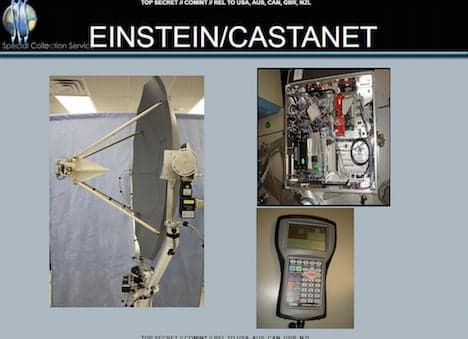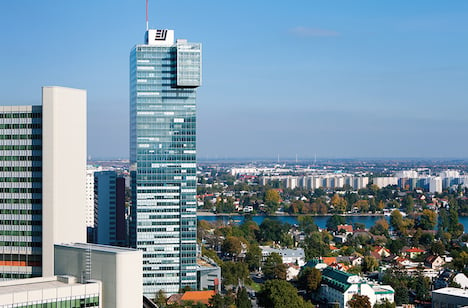NSA spying in Vienna detailed at Chaos meet

Austrian journalist Erich Möchel delivered a presentation in Hamburg at the annual meeting of the Chaos Computer Club on Monday December 29, detailing the various locations where the US NSA has been actively collecting and processing electronic intelligence in Vienna.
According to a report in the Austrian news daily Der Standard, Möchel had made extensive use of the documents revealed by Edward Snowden, the former systems administrator and defense contractor with Booz Allen Hamilton who allegedly leaked NSA and CIA secret archives.
The documents show that the American National Security Agency operates a robust presence in the Austrian capital, and with good reason. Despite Vienna having a population of only 1.75 million people, the city is home to more than 17,000 accredited diplomats, many of whom work in the various international organizations, including the United Nations, IAEA, UNIDO, CTBTO, OSCE and OPEC.
That means nearly 1 percent of Vienna's population have diplomatic status - and a significant portion of those are likely to be spies, according to Austrian investigative journalist Emil Bobi, who estimates that there are more than 7,000 spooks living in the city.
As a result, the NSA has plenty of monitoring to do in Austria's capital, especially considering that the oil-rich Arab states meet regularly in OPEC, and Vienna has long been the centre for East-West spy activities.
According Möchel there are currently three major NSA stations in Vienna. The most obvious one is the US Embassy in Vienna's 9th district, with its roof-based monitoring antennas, similar to many other embassies around the world, according to Snowden's revelations.

Photo: IZD Tower
The second major station is positioned on upper floors of the Internationales Zentrum Donaustadt (IZD) tower, overlooking the Vienna International Centre, which is the third-largest home for United Nations-affiliated organizations, such as the International Atomic Energy Agency. It's responsible for electronic surveillance of important UN-related activities, as well as coordinating SigInt from other foreign embassies.
The third location is the so-called "NSA Villa" in Pötzleinsdorf. According to Möchel, the villa was previously tasked with collecting more analog forms of intel, based on older technologies, but this is largely being phased out, and staff are being relocated to the IZD tower.
Each of the three stations are connected by a secure broadband network, with a radio tower in Exelberg serving as a relay station. Much of the operational processing takes place in the IZD tower, says Möchel.
According to Möchel, the NSA's Special Collection Service EINSTEIN/CASTANET is located on the top floor of the U.S. embassy in Berlin and elsewhere (Special Collection Service). This is not a transmitting antenna system, though it can be used for transmitting/illumination/RF flooding/etc. This is a wideband microwave SIGINT (bug repeater, telco microwave backbones, WiFi, GSM/cellular, satellite up/downlinks, GBPPR, etc.) collection system.
He added that the tower recently added more air-conditioning plants, indicating that additional computers were probably installed, and mobile phones often fail to operate there, suggesting that localized jamming or other security measures may be employed.
Möchel doubts that the NSA has much interest in Austrian internet traffic, since most such traffic flows through Frankfurt, where a joint US-German operation searches through it for anything of relevance. However, the Snowden documents strongly suggest that the NSA has successfully infiltrated the mobile and data networks of Telekom Austria on occasion.
Siegfried Beer, director of the Austrian Centre for Intelligence, Propaganda and Security Studies, at the University of Graz, agrees that there are at least 7,000 agents based in Vienna, working in embassies and international organizations.
Bobi says that one reason spies feel so comfortable in Vienna is that “the so-called real Viennese operate in the private sector in the same way as intelligence agencies do.” Former police officers and politicians, as well as cabaret artists and psychoanalysts are employed as agents, Bobi claims.
“Spies love being sent to work in Vienna, because of the high quality of life, and its geographical location. Some even return here once they retire,” he added. Austria has been an international spy hub since the late 19th Century, when people from all parts of the Austro-Hungarian empire flocked to the city.
Comments
See Also
According to a report in the Austrian news daily Der Standard, Möchel had made extensive use of the documents revealed by Edward Snowden, the former systems administrator and defense contractor with Booz Allen Hamilton who allegedly leaked NSA and CIA secret archives.
The documents show that the American National Security Agency operates a robust presence in the Austrian capital, and with good reason. Despite Vienna having a population of only 1.75 million people, the city is home to more than 17,000 accredited diplomats, many of whom work in the various international organizations, including the United Nations, IAEA, UNIDO, CTBTO, OSCE and OPEC.
That means nearly 1 percent of Vienna's population have diplomatic status - and a significant portion of those are likely to be spies, according to Austrian investigative journalist Emil Bobi, who estimates that there are more than 7,000 spooks living in the city.
As a result, the NSA has plenty of monitoring to do in Austria's capital, especially considering that the oil-rich Arab states meet regularly in OPEC, and Vienna has long been the centre for East-West spy activities.
According Möchel there are currently three major NSA stations in Vienna. The most obvious one is the US Embassy in Vienna's 9th district, with its roof-based monitoring antennas, similar to many other embassies around the world, according to Snowden's revelations.

Photo: IZD Tower
The second major station is positioned on upper floors of the Internationales Zentrum Donaustadt (IZD) tower, overlooking the Vienna International Centre, which is the third-largest home for United Nations-affiliated organizations, such as the International Atomic Energy Agency. It's responsible for electronic surveillance of important UN-related activities, as well as coordinating SigInt from other foreign embassies.
The third location is the so-called "NSA Villa" in Pötzleinsdorf. According to Möchel, the villa was previously tasked with collecting more analog forms of intel, based on older technologies, but this is largely being phased out, and staff are being relocated to the IZD tower.
Each of the three stations are connected by a secure broadband network, with a radio tower in Exelberg serving as a relay station. Much of the operational processing takes place in the IZD tower, says Möchel.
According to Möchel, the NSA's Special Collection Service EINSTEIN/CASTANET is located on the top floor of the U.S. embassy in Berlin and elsewhere (Special Collection Service). This is not a transmitting antenna system, though it can be used for transmitting/illumination/RF flooding/etc. This is a wideband microwave SIGINT (bug repeater, telco microwave backbones, WiFi, GSM/cellular, satellite up/downlinks, GBPPR, etc.) collection system.
He added that the tower recently added more air-conditioning plants, indicating that additional computers were probably installed, and mobile phones often fail to operate there, suggesting that localized jamming or other security measures may be employed.
Möchel doubts that the NSA has much interest in Austrian internet traffic, since most such traffic flows through Frankfurt, where a joint US-German operation searches through it for anything of relevance. However, the Snowden documents strongly suggest that the NSA has successfully infiltrated the mobile and data networks of Telekom Austria on occasion.
Siegfried Beer, director of the Austrian Centre for Intelligence, Propaganda and Security Studies, at the University of Graz, agrees that there are at least 7,000 agents based in Vienna, working in embassies and international organizations.
Bobi says that one reason spies feel so comfortable in Vienna is that “the so-called real Viennese operate in the private sector in the same way as intelligence agencies do.” Former police officers and politicians, as well as cabaret artists and psychoanalysts are employed as agents, Bobi claims.
Austria has been an international spy hub since the late 19th Century, when people from all parts of the Austro-Hungarian empire flocked to the city.
Join the conversation in our comments section below. Share your own views and experience and if you have a question or suggestion for our journalists then email us at [email protected].
Please keep comments civil, constructive and on topic – and make sure to read our terms of use before getting involved.
Please log in here to leave a comment.